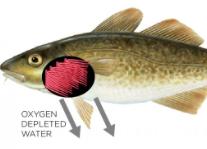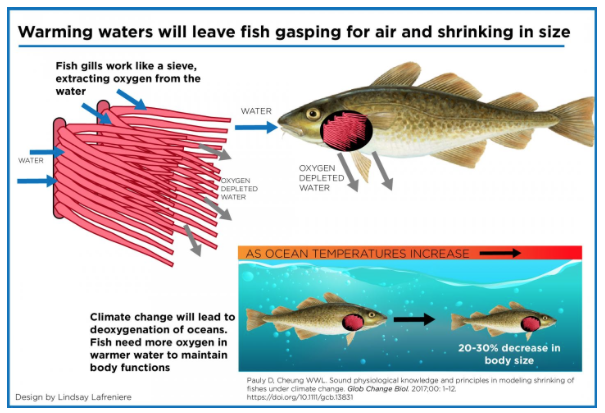
If the oceans continue to warm, a new study released today postulates that the size of fish gills will face new limits, with many species subsequently shrinking in size as compared today's population due to the intake of less oxygen in warmer water.
Meanwhile, the author of an earlier study on the subject published five months ago in the same journal, Global Change Biology, disagrees with this latest theory, saying she's "not at all impressed or convinced" by the attempt to undercut her argument that no evidence of this prediction exists.
The new study, produced by researchers from the University of British Columbia, say fish size will shrink by 20 to 30 percent if the current warming trend continues because when "waters get warmer, their metabolism accelerates and they need more oxygen to sustain their body functions. There is a point where the gills cannot supply enough oxygen for a larger body, so the fish just stops growing larger."
That's according to William Cheung, co-author of the study, associate professor at the Institute for the Ocean and Fisheries and the director of science for the Nippon Foundation-UBC Nereus Program. The lead author is Daniel Pauly, who is also the principal investigator of the "Sea Around Us" at the Institute for the Ocean and Fisheries.
The authors advance a concept called "Gill-Oxygen Limitation Theory" or GOLT, where the gills do not grow at the same pace as the rest of a fish's body. With the reduced oxygen intake, they reason, fish will not be able to grow to their current size. (See adjacent infographic, courtesy of Lindsay Lafreniere & Univ. of British Columbia.) In 2013 they wrote that this difference could affect up to 600 species of ocean fish.
"The surface area of the gills – where oxygen is obtained – does not grow at the same pace as the rest of the body," states Pauly, citing that a cod's gills grow to 80 just percent as compared to the rest of the body. Moreover, the authors note that since fish, "as cold-blooded animals, cannot regulate their own body temperatures" they will be more or less – some species could relocate to more oxygen-rich waters – subjected to their new, warmer surroundings.
 "Available empirical evidence corroborates predictions of decrease in body sizes under ocean warming based on GOLT," the authors wrote, "with the magnitude of the predicted change increases when using more species-specific parameter values of metabolic scaling." They add that "an alternative to GOLT, offering a more parsimonious explanation for these features of water-breathers has not been proposed."
"Available empirical evidence corroborates predictions of decrease in body sizes under ocean warming based on GOLT," the authors wrote, "with the magnitude of the predicted change increases when using more species-specific parameter values of metabolic scaling." They add that "an alternative to GOLT, offering a more parsimonious explanation for these features of water-breathers has not been proposed."
However, don't tell that to the University of Oslo's Sjannie Lefevre, a physiologist who recently wrote that, "papers projecting smaller fish sizes and catches in a warmer future are based on erroneous assumptions," which fail to recognize the fact that gills "are folded surfaces, where the scaling of surface area to volume is not constrained by spherical geometry. The gill surface area can, in fact, increase linearly in proportion to gill volume and body mass. We cite the large body of evidence demonstrating that respiratory surface areas in fishes reflect metabolic needs, not vice versa, which explains the large interspecific variation in scaling of gill surface areas."
"There are no geometric constraints stopping gills from growing as fast as the body of a fish," said Lefevre, in an interview with National Geographic criticizing the new study. "I am not at all impressed or convinced by their attempt to refute our arguments."



